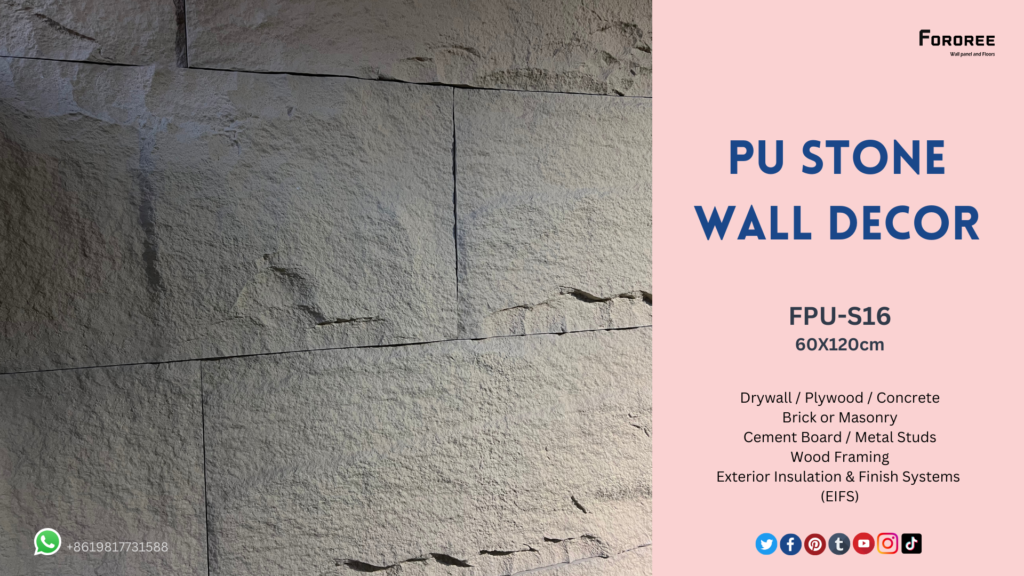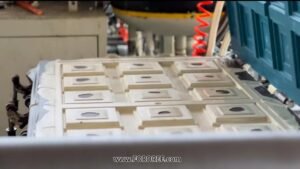Polyurethane (PU) stone panels are typically made using a combination of raw materials that undergo a manufacturing process to create the final product. The specific composition may vary among manufacturers, but here are common raw materials used in the production of PU stone panels:
- Polyurethane Resin: The primary component is polyurethane resin, a versatile polymer that can be molded into various shapes. It provides flexibility, durability, and a realistic texture to the panels.
- Fillers and Reinforcements: To enhance strength and stability, fillers and reinforcements are often added. These may include materials like calcium carbonate, fiberglass, or other minerals.
- Colorants and Pigments: To achieve the desired color and appearance, colorants and pigments are incorporated into the polyurethane mixture. This ensures that the panels closely mimic the look of natural stone.
- Release Agents: These agents facilitate the removal of the finished panels from molds during the manufacturing process.
- Blowing Agents: In some cases, blowing agents are used to create a cellular structure within the polyurethane, resulting in a lighter and more porous material.
- Curing Agents: These agents help initiate and control the curing process of polyurethane, ensuring that the material solidifies properly.
- UV Stabilizers: If the panels are intended for outdoor use, UV stabilizers may be added to protect the material from sunlight and prevent color fading.
- Flame Retardants: In applications where fire resistance is a concern, flame retardants may be included to enhance the fire-resistant properties of the panels.
The exact formulation can vary based on the manufacturer’s proprietary processes and the specific characteristics they aim to achieve in the final product. It’s important to note that the use of polyurethane allows for a high degree of customization and flexibility in creating realistic and durable faux stone panels.

Which raw material for PU Stone wall panel is the key point?
In the production of PU (polyurethane) stone panels, the key raw material is polyurethane resin. Polyurethane serves as the primary component because of its versatile properties that contribute to the overall quality and characteristics of the panels. Here’s why polyurethane resin is a key point in the production:
- Versatility: Polyurethane is highly adaptable, allowing for the creation of intricate designs and textures. This versatility is crucial in mimicking the appearance of natural stone.
- Flexibility: Polyurethane panels are flexible, making them easier to handle and install. This flexibility also contributes to their durability, as the panels can withstand some degree of bending and impact without breaking.
- Realistic Texture: Polyurethane can be molded to replicate the texture and details of natural stone surfaces. This is essential for achieving a realistic and aesthetically pleasing appearance.
- Lightweight: Polyurethane is a lightweight material, making the panels easier to transport and install compared to natural stone. This is particularly advantageous for applications where weight is a concern.
- Durability: Polyurethane provides durability, ensuring that the panels maintain their structural integrity over time. It is resistant to wear, impact, and environmental factors, contributing to the longevity of the product.
While other additives and materials, such as fillers, reinforcements, colorants, and stabilizers, play important roles in enhancing specific properties of the panels, polyurethane resin remains the key ingredient that defines the overall performance and characteristics of PU stone panels.
Which glassfiber will be good for pu stonal panel raw material?
When selecting glass fibers for use in PU (polyurethane) stone panel raw materials, it’s essential to consider the specific characteristics and requirements of the panels. Here are some key considerations for choosing suitable glass fibers:
- Type of Glass Fiber:
- E-Glass (E-Glass Fiber): E-Glass is a commonly used type of glass fiber for construction and composite materials. It offers good strength and chemical resistance.
- S-Glass (S-Glass Fiber): S-Glass is known for its higher tensile strength and modulus compared to E-Glass. It may be chosen for applications requiring enhanced performance.
- Length of Fibers:
- The length of the glass fibers can influence the mechanical properties of the composite material. Short fibers (chopped fibers) are often used for reinforcing polyurethane composites.
- Surface Treatment:
- Some glass fibers are treated with a sizing or coating to improve their compatibility with the polyurethane matrix. This treatment enhances adhesion between the fibers and the polymer.
- Compatibility with Polyurethane:
- Ensure that the chosen glass fibers are compatible with polyurethane resin. Compatibility is crucial for achieving effective reinforcement and maintaining the integrity of the composite material.
- Resistance to Environmental Factors:
- Consider the environmental conditions to which the PU stone panels will be exposed. Choose glass fibers that are resistant to environmental factors such as moisture, UV radiation, and temperature changes.
- Product Specifications:
- Review the product specifications provided by the glass fiber manufacturer. Look for information on tensile strength, modulus, and other mechanical properties.
- Certifications and Standards:
- Check if the glass fibers meet relevant industry standards and certifications for construction and composite materials.
- Cost Considerations:
- Evaluate the cost-effectiveness of the glass fibers in relation to the desired performance characteristics of the PU stone panels.
It’s important to collaborate with suppliers and manufacturers to ensure that the selected glass fibers align with the intended properties of the PU stone panels. Testing and quality assurance processes are also crucial to validate the performance of the composite material.
What kind of colourants can be used to prolong the chroma?
To prolong the chroma or color vibrancy of PU (polyurethane) stone panels, manufacturers may use colorants that are resistant to fading, UV degradation, and environmental factors. Here are some types of colorants commonly used for this purpose:
- UV-Stable Pigments: UV-stable pigments are designed to resist the effects of ultraviolet (UV) radiation from sunlight. These pigments help prevent color fading and maintain the vibrancy of the panels when exposed to outdoor conditions.
- Inorganic Pigments: Inorganic pigments, such as iron oxide pigments, are known for their stability and resistance to environmental factors. They are less prone to fading compared to some organic pigments.
- Mineral Pigments: Certain mineral pigments, like titanium dioxide, are often used for their ability to maintain color stability in various conditions. Titanium dioxide is known for its UV-blocking properties.
- Weather-Resistant Dyes: Some weather-resistant dyes may be used to enhance color stability. These dyes are formulated to withstand exposure to sunlight and other weather elements.
- Color Stabilizers: Color stabilizers, including additives and chemicals, can be incorporated into the formulation to protect against color degradation over time.
- Polymeric Colorants: Polymeric colorants are designed to be more durable and stable, offering improved resistance to fading and environmental factors.
When considering PU stone panels for outdoor applications or areas with exposure to sunlight, it’s important to choose panels with colorants specifically formulated for UV resistance. Additionally, manufacturers may conduct testing to ensure that the colorants used meet certain performance standards.
For specific information on the colorants used in PU stone panels from a particular manufacturer, it’s advisable to check the product specifications provided by the manufacturer or contact them directly.
What kind of flame retardants are suitable for pu stone panel production?
Flame retardants are important additives in the production of PU (polyurethane) stone panels to enhance their fire resistance. Several types of flame retardants can be suitable for PU materials. Here are some commonly used flame retardants in PU formulations:
- Halogenated Flame Retardants:
- Brominated Compounds: Brominated flame retardants, such as hexabromocyclododecane (HBCD) or tetrabromobisphenol A (TBBPA), are effective in slowing down the combustion process. However, there are environmental concerns associated with some brominated flame retardants.
- Phosphorus-Based Flame Retardants:
- Phosphates: Phosphorus-containing compounds, like organophosphates or phosphonates, can act as flame retardants. They work by disrupting the combustion process.
- Inorganic Flame Retardants:
- Aluminum Hydroxide (ATH) and Magnesium Hydroxide (MDH): These inorganic compounds release water vapor when exposed to heat, which helps cool down the material and suppress flames.
- Nitrogen-Based Flame Retardants:
- Melamine: Melamine is a nitrogen-containing compound that can release inert gases when exposed to heat, diluting flammable gases and reducing the risk of ignition.
- Intumescent Flame Retardants:
- Ammonium Polyphosphate (APP) and Pentaerythritol: Intumescent flame retardants can expand and form a protective char layer when exposed to heat, providing insulation and preventing further combustion.
When selecting flame retardants for PU stone panels, it’s crucial to consider the specific requirements, performance goals, and any regulations or standards governing fire safety in the intended application. Additionally, be mindful of environmental and health considerations associated with certain flame retardants, and choose formulations that align with relevant safety guidelines and regulations. Manufacturers often conduct testing to ensure that the flame retardants used meet specific performance criteria.
PU Stone Panels use which kind of uv stabilizer is best choice?
The selection of the best UV stabilizer for PU (polyurethane) stone panels depends on various factors, including the specific formulation of the polyurethane, the intended application, and the environmental conditions to which the panels will be exposed. Here are two common types of UV stabilizers used in PU applications:
- UV Absorbers:
- UV absorbers are chemicals that absorb ultraviolet (UV) radiation and convert it into heat, preventing the UV rays from reaching the polyurethane matrix. These stabilizers are effective in protecting against color fading and degradation caused by UV exposure.
- Hindered Amine Light Stabilizers (HALS):
- HALS are a type of UV stabilizer that scavenges free radicals generated by UV radiation. By inhibiting the formation and propagation of free radicals, HALS help prevent the degradation of polyurethane polymers. They are particularly effective in extending the lifespan of materials exposed to outdoor conditions.
The choice between UV absorbers and HALS, or a combination of both, depends on the specific requirements and characteristics of the PU stone panels. Manufacturers often formulate their products based on the desired UV protection, color stability, and environmental resistance. It’s recommended to consult with the manufacturer or supplier of the PU stone panels to understand the UV stabilizer used in their specific formulation and its suitability for the intended application.
In outdoor applications where prolonged UV exposure is expected, a combination of UV absorbers and HALS may provide comprehensive protection against UV degradation. Additionally, adherence to relevant industry standards and testing procedures can help ensure the effectiveness of the chosen UV stabilizers.




